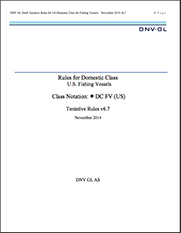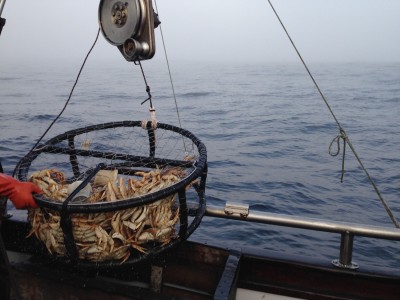The Coast Guard Authorization Act of 2010 called for fishing boats to meet survey and classification requirements if they are 50 feet and over, operate outside of three miles and are built after July 1, 2013. The regulation has been called a huge cultural change.
Critics said the fishing industry had virtually "no input" in the law, and making matters worse has been the lack of guidelines describing a classed boat from any of the possible classification societies: American Bureau of Shipping, DNV GL (previously Det Norske Veritas), Lloyd's Register, Bureau Veritas or Germanischer Lloyd.
 The DNV GL report covers classifying standards for fishing vessels 50 feet and over that operate in federal waters and are built after July 1, 2013. DNV GL photoSome of that mystery was cleared up this past November at Pacific Marine Expo in Seattle when DNV GL's Joar Bengaard talked about some of DNV GL's classing requirements contained in a November 2014, 90-page document, "Rules for Domestic Class U.S. fishing Vessels."
The DNV GL report covers classifying standards for fishing vessels 50 feet and over that operate in federal waters and are built after July 1, 2013. DNV GL photoSome of that mystery was cleared up this past November at Pacific Marine Expo in Seattle when DNV GL's Joar Bengaard talked about some of DNV GL's classing requirements contained in a November 2014, 90-page document, "Rules for Domestic Class U.S. fishing Vessels."
This might not be the final version, as it is labeled "Tentative Rules v6.7."
DNV GL's classifying standards apply to boats from 50 to 148 feet overall length. Larger boats fall under DNV GL's Rules for Classification of Ships. If a boat has speeds in excess of 15 knots, different rules apply.
Classing a boat starts with the builder submitting a request for classifications and the builder or designer then submitting plans and specifications to DNV GL.
Construction inspections will take place, with DNV GL determining their frequency and duration. Once completed, the boat has a class certificate valid for five years, and the boat will be subject to annual surveys. Bengaard said in some cases the owner may do those surveys.
The 90-page document covers just about everything that goes into a boat's construction and operation. That includes DNV GL approval of welding procedures, stability requirements for various loading conditions, anchoring and mooring equipment.
The rules also establish requirements for certification of materials, components and systems. That could mean classing machinery such as engines and gears, which could be costly, but Bengaard said, "Not many materials and equipment will be classed." Industry accepted standards would be substituted for a rigorous classifying procedure. Though that might not apply to shafting and switchboards. DNV GL will have to certify and approve new machinery and components that have not previously been used in the fishing industry.
In summary, there's a lot in this publication, but I'm sure any qualified naval architect is familiar with most if not all of it, and why a fisherman has to pay for a classification society to get between him and the naval architect, I still don't understand.
Lastly, the rules are for a boat, as stated above, between 50 and 148 feet. I suspect that what goes into a 145-foot boat in terms of structural members, stability and watertight integrity is different from what is required for a 58 footer. In fact, the rules in the document are partly based on DNV GL's Rules for Classification of Ships.
Might it not have been more practical to have DNV GL's class rules apply to boats 50 to 79 feet?
But take a look at the document, because if you are going to be building a 50-foot or longer boat, these standards will apply to you.







